Rosetta - 2 days to comet Churyumov-Gerasimenko
After 10 years, the Rosetta spacecraft at the finish line is going to do what no one could have done before - to go into the orbit of a comet. On Wednesday, August 6th, Rosetta is expected to go into orbit with the comet, completing its journey of 6.4 billion kilometers.
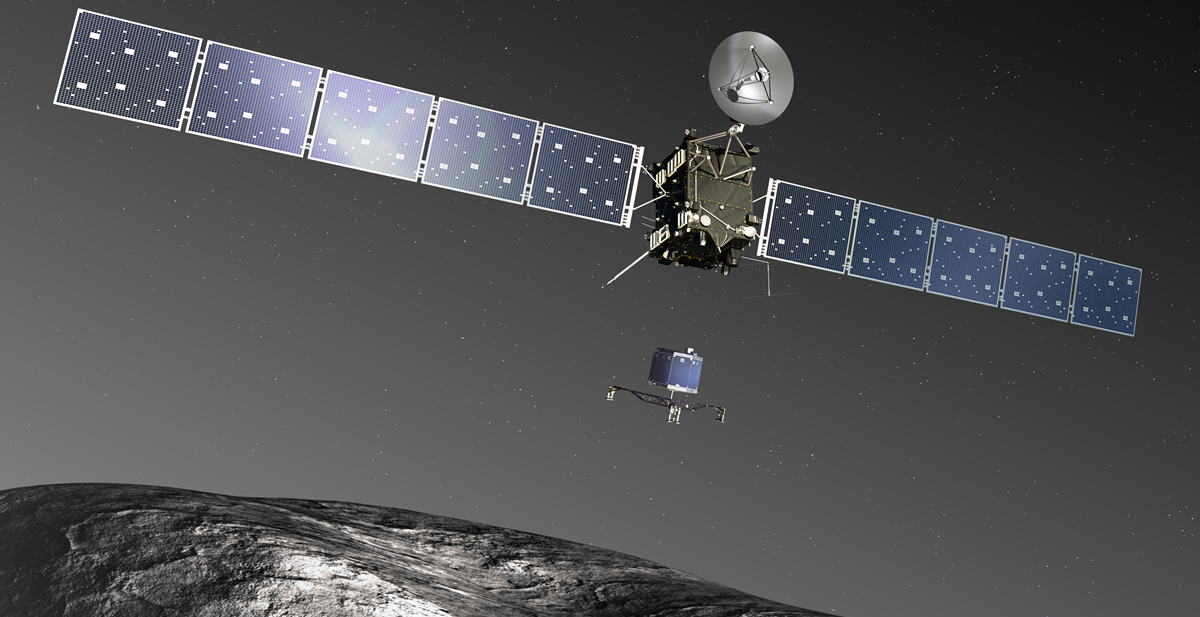
About the Rosetta mission has already been written on Habré, this post we will try to supplement. After two canceled attempts (engine failure), the Rosetta unit was launched from the Kourou (Guyana) cosmodrome on March 2, 2004 using the Ariane-5G + launch vehicle.
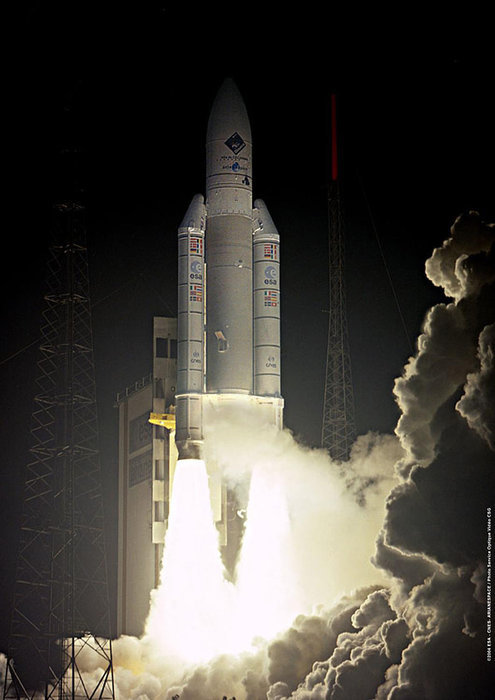
')
Using the gravitational fields of the Earth and Mars, the apparatus managed to set the required speed, after which Rosetta headed for the comet, having managed to take many beautiful photographs along the way. Then Rosetta was immersed in hibernation, and successfully “woke up” in January 2014. At the same time, this was the longest term of hibernation of the spacecraft - 957 days.
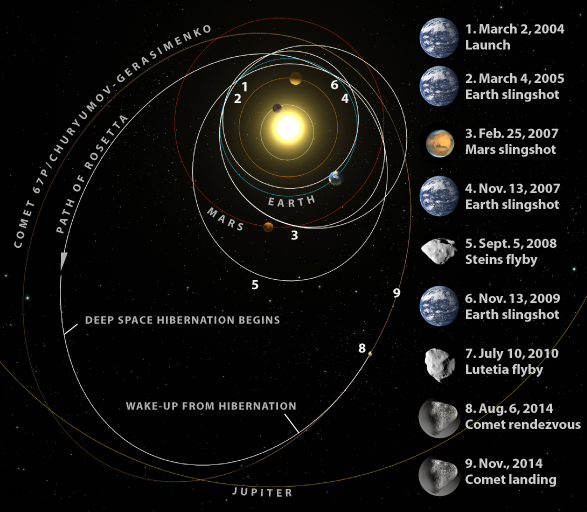
At a distance of 350 km of Rosetta recorded the evaporation of water in a volume of 300 ml per second, and this is at a distance of 583 million kilometers from the Sun, with the approach to the Sun, this figure will begin to increase dramatically.
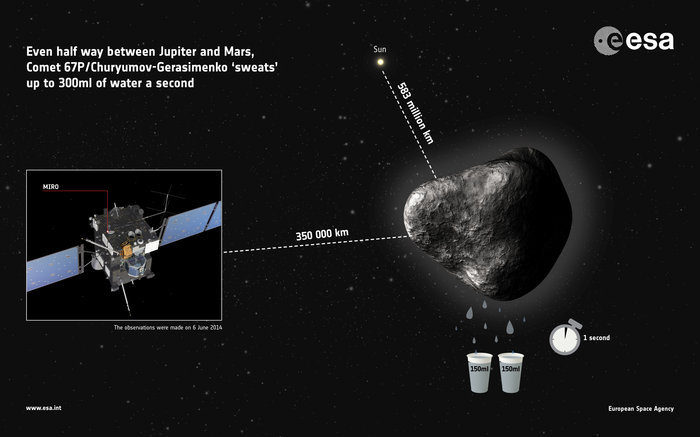
There are 11 scientific instruments onboard the Rosetta (the name of each has a link to the specification in English, do not consider it an advertisement, just pdf was more convenient there):

ALICE . Ultraviolet Spectrometer - determines the characteristics of the composition of the nucleus of the comet and coma. Analyzes gases in a coma and a tail, measures rates of release of water and oxide / carbon dioxide.
CONSERT (Comet Nucleus Sounding Experiment by Radio Wave Transmission) - studies the internal structure of a comet with the Philae landing module.
COSIMA (Cometary Secondary Ion Mass Analyzer) - studies the composition of dust in a comet's coma. Makes a test for organic.
GIADA (Grain Impact Analyzer and Dust Accumulator) - measures the amount, mass, momentum and speed of dust particles in the environment of a comet.
MIDAS (Micro-Imaging Dust Analysis System) - studies dust in a comet's environment.
MIRO (Microwave Instrument for the Rosetta Orbiter) - explores the nature of the cometary nucleus, degassing from the nucleus and the development of coma. Determines the core temperature.
OSIRIS (Optical, Spectroscopic, and Infrared Remote Imaging System Camera) is a dual photo device consisting of narrow and wide viewing angle cameras that operates in the visible, infrared and ultraviolet ranges.
ROSINA (Rosetta Orbiter Spectrometer for Ion and Neutral Analysis) is responsible for determining the composition of the atmosphere of the comet and ionosphere, measuring the temperature, velocity and density of the gas flow. It consists of 2 spectrometers and a sensor: DFMS (Double-focusing mass spectrometer), RTOF (Reflectron Time-Of-Flight mass spectrometer) and COPS (Comet Pressure Sensor).
RPC (Rosetta Plasma Consortium) - studies the comet's plasma environment. Consists of ICA (Ion Composition Analyzer), IES (Ion and Electron Sensor), LAP (Langmuir Probe), MAG (Fluxgate Magnetometer), MIP (Mutual Impedance Probe), PIU (Plasma Interface Unit).
RSI (Radio Science Investigation) - studies the mass, density and gravity of a comet's nucleus, the definition of a comet's orbit. The study of the solar corona on the way to the target comet.
VIRTIS (Visible and Infrared Thermal Imaging Spectrometer) - studies the nature of a comet's nucleus and gases in a coma. It maps and explores the nature of hard rock, determines the temperature on the surface of the core. It also detects comet gases, characterizes the physical conditions in the coma, and helps determine the optimal landing sites.
Since May 2014, the device is slowing down. By a sequence of complex maneuvers, he must go into the orbit of comet Churyumov-Gerasimenko, moving 1m / s faster. The comet is currently flying at a speed of 55'000km / h.
In November 2014, there will be a discharge of the Philae apparatus, which will investigate the soil and the environment on a comet.
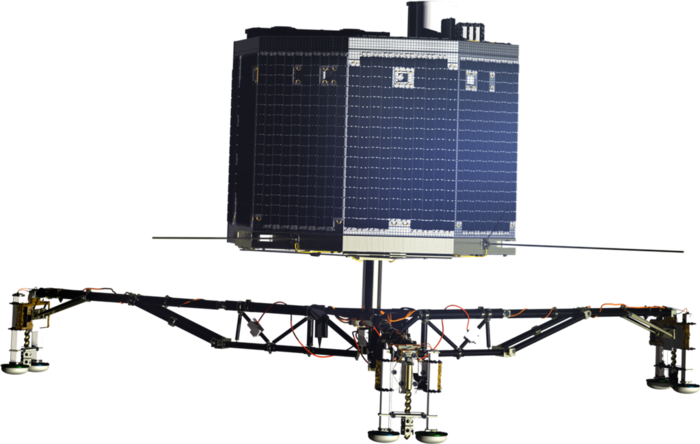
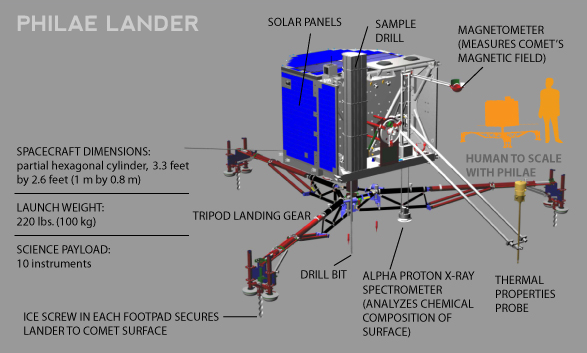
In the period from July 13 to 21, Rosetta measured temperature on comet Churyumov-Gerasimenko with VIRTIS and it was -70 ° C, which turned out to be 20-30 degrees higher than expected. The data transfer rate from Rosetta at the moment is 38088.4232bps. On the 3rd of August the most recent images of the comet were published from a distance of 300km:
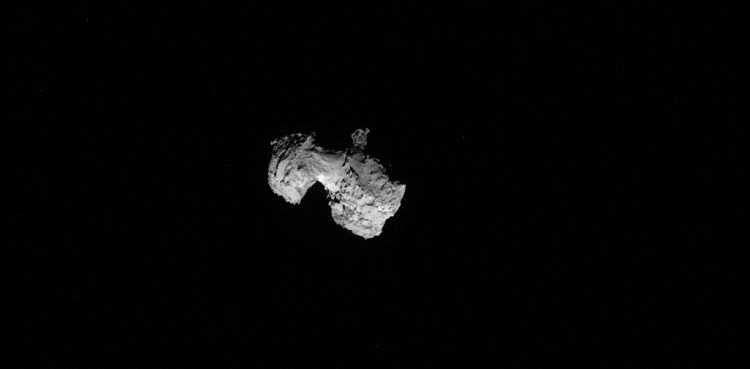
Above the 3D-visualization in ESA they did their best, it turned out very cool, we click and watch Rosetta all the way. And subscribing to Rosetta twitter (which, by the way, is funny from the first person), will soon be followed by a lot of interesting news.
UPD1: August 4th, 234km distance:
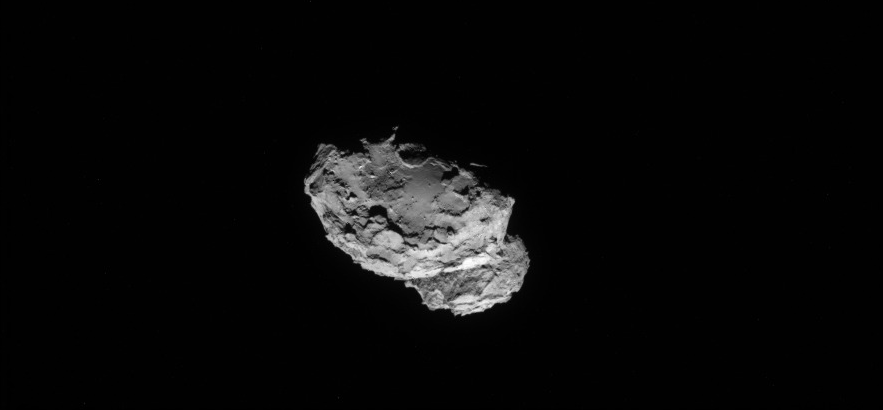

About the Rosetta mission has already been written on Habré, this post we will try to supplement. After two canceled attempts (engine failure), the Rosetta unit was launched from the Kourou (Guyana) cosmodrome on March 2, 2004 using the Ariane-5G + launch vehicle.

')
Using the gravitational fields of the Earth and Mars, the apparatus managed to set the required speed, after which Rosetta headed for the comet, having managed to take many beautiful photographs along the way. Then Rosetta was immersed in hibernation, and successfully “woke up” in January 2014. At the same time, this was the longest term of hibernation of the spacecraft - 957 days.

At a distance of 350 km of Rosetta recorded the evaporation of water in a volume of 300 ml per second, and this is at a distance of 583 million kilometers from the Sun, with the approach to the Sun, this figure will begin to increase dramatically.

There are 11 scientific instruments onboard the Rosetta (the name of each has a link to the specification in English, do not consider it an advertisement, just pdf was more convenient there):

ALICE . Ultraviolet Spectrometer - determines the characteristics of the composition of the nucleus of the comet and coma. Analyzes gases in a coma and a tail, measures rates of release of water and oxide / carbon dioxide.
CONSERT (Comet Nucleus Sounding Experiment by Radio Wave Transmission) - studies the internal structure of a comet with the Philae landing module.
COSIMA (Cometary Secondary Ion Mass Analyzer) - studies the composition of dust in a comet's coma. Makes a test for organic.
GIADA (Grain Impact Analyzer and Dust Accumulator) - measures the amount, mass, momentum and speed of dust particles in the environment of a comet.
MIDAS (Micro-Imaging Dust Analysis System) - studies dust in a comet's environment.
MIRO (Microwave Instrument for the Rosetta Orbiter) - explores the nature of the cometary nucleus, degassing from the nucleus and the development of coma. Determines the core temperature.
OSIRIS (Optical, Spectroscopic, and Infrared Remote Imaging System Camera) is a dual photo device consisting of narrow and wide viewing angle cameras that operates in the visible, infrared and ultraviolet ranges.
ROSINA (Rosetta Orbiter Spectrometer for Ion and Neutral Analysis) is responsible for determining the composition of the atmosphere of the comet and ionosphere, measuring the temperature, velocity and density of the gas flow. It consists of 2 spectrometers and a sensor: DFMS (Double-focusing mass spectrometer), RTOF (Reflectron Time-Of-Flight mass spectrometer) and COPS (Comet Pressure Sensor).
RPC (Rosetta Plasma Consortium) - studies the comet's plasma environment. Consists of ICA (Ion Composition Analyzer), IES (Ion and Electron Sensor), LAP (Langmuir Probe), MAG (Fluxgate Magnetometer), MIP (Mutual Impedance Probe), PIU (Plasma Interface Unit).
RSI (Radio Science Investigation) - studies the mass, density and gravity of a comet's nucleus, the definition of a comet's orbit. The study of the solar corona on the way to the target comet.
VIRTIS (Visible and Infrared Thermal Imaging Spectrometer) - studies the nature of a comet's nucleus and gases in a coma. It maps and explores the nature of hard rock, determines the temperature on the surface of the core. It also detects comet gases, characterizes the physical conditions in the coma, and helps determine the optimal landing sites.
Since May 2014, the device is slowing down. By a sequence of complex maneuvers, he must go into the orbit of comet Churyumov-Gerasimenko, moving 1m / s faster. The comet is currently flying at a speed of 55'000km / h.
In November 2014, there will be a discharge of the Philae apparatus, which will investigate the soil and the environment on a comet.


In the period from July 13 to 21, Rosetta measured temperature on comet Churyumov-Gerasimenko with VIRTIS and it was -70 ° C, which turned out to be 20-30 degrees higher than expected. The data transfer rate from Rosetta at the moment is 38088.4232bps. On the 3rd of August the most recent images of the comet were published from a distance of 300km:

Above the 3D-visualization in ESA they did their best, it turned out very cool, we click and watch Rosetta all the way. And subscribing to Rosetta twitter (which, by the way, is funny from the first person), will soon be followed by a lot of interesting news.
UPD1: August 4th, 234km distance:

Source: https://habr.com/ru/post/232221/
All Articles